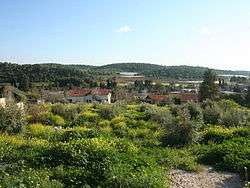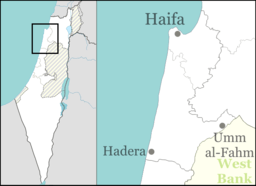Amikam
Amikam (Hebrew: עַמִּיקָם) is a moshav in northern Israel. Located near Zikhron Ya'akov, it falls under the jurisdiction of Alona Regional Council, whose headquarters are located in the moshav. In 2018 it had a population of 738.[1] West of the moshav is the Alona Park.[2]
Amikam עַמִּיקָם | |
|---|---|
| Hebrew transcription(s) | |
| • official | Ammiqam |
 | |
 Amikam  Amikam | |
| Coordinates: 32°33′49.31″N 35°1′14.51″E | |
| Country | |
| District | Haifa |
| Council | Alona |
| Affiliation | Mishkei Herut Beitar |
| Founded | 1950 |
| Founded by | Immigrants from China |
| Population (2018)[1] | 738 |
History
The moshav was established in 1950 by Jewish refugees from Harbin, Manchuria and Shanghai, China, who had fled the Chinese Civil War.[2] The land had belonged to the depopulated Palestinian village of Sabbarin.[3]
The founders were later joined by Jews from the Cyprus concentration camps, and followed by Yemenite Jews. In 1956, a group of Polish Jewish immigrants settled on the moshav. Some of the families engage in fruit farming, raising peaches, plums, nectarines and loquats. Children attend the local Tali Alona elementary school.[4]
Agriculture
A rare variety of peach was grown on Moshav Amikam and named for the moshav. Pits from this variety were found on Masada. Now the one remaining tree is in Kfar Kara.[5]
Notable residents
References
- "Population in the Localities 2018" (XLS). Israel Central Bureau of Statistics. 25 August 2019. Retrieved 26 August 2019.
- Mapa's concise gazetteer of Israel (in Hebrew). Yuval El'azari (ed.). Tel-Aviv: Mapa Publishing. 2005. pp. 426–427. ISBN 965-7184-34-7.CS1 maint: others (link)
- Khalidi, Walid (1992). All That Remains: The Palestinian Villages Occupied and Depopulated by Israel in 1948. Washington D.C.: Institute for Palestine Studies. p. 187. ISBN 0-88728-224-5.
- Alona region
- Shapira, Ran (November 30, 2011). "What peach did they dare to eat at Masada?". Haaretz. Retrieved April 23, 2019.
External links
| Wikimedia Commons has media related to Amikam. |
- Weekend Walk: Moshav Amikam[1]
- Mey Kedem, archaeological site centered on a Roman water tunnel
- Cohen, Yoni (April 22, 2012). "Weekend Walk: Moshav Amikam". The Jerusalem Post. Retrieved April 23, 2019.